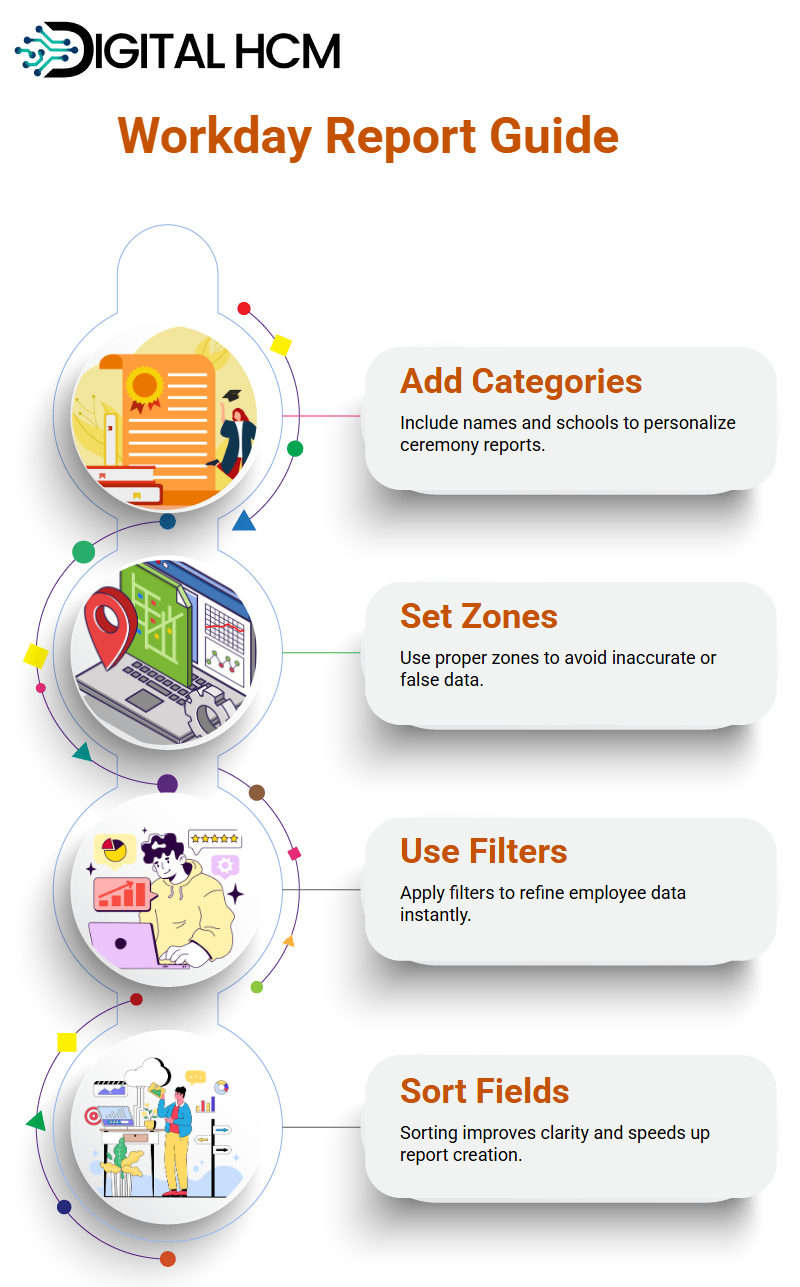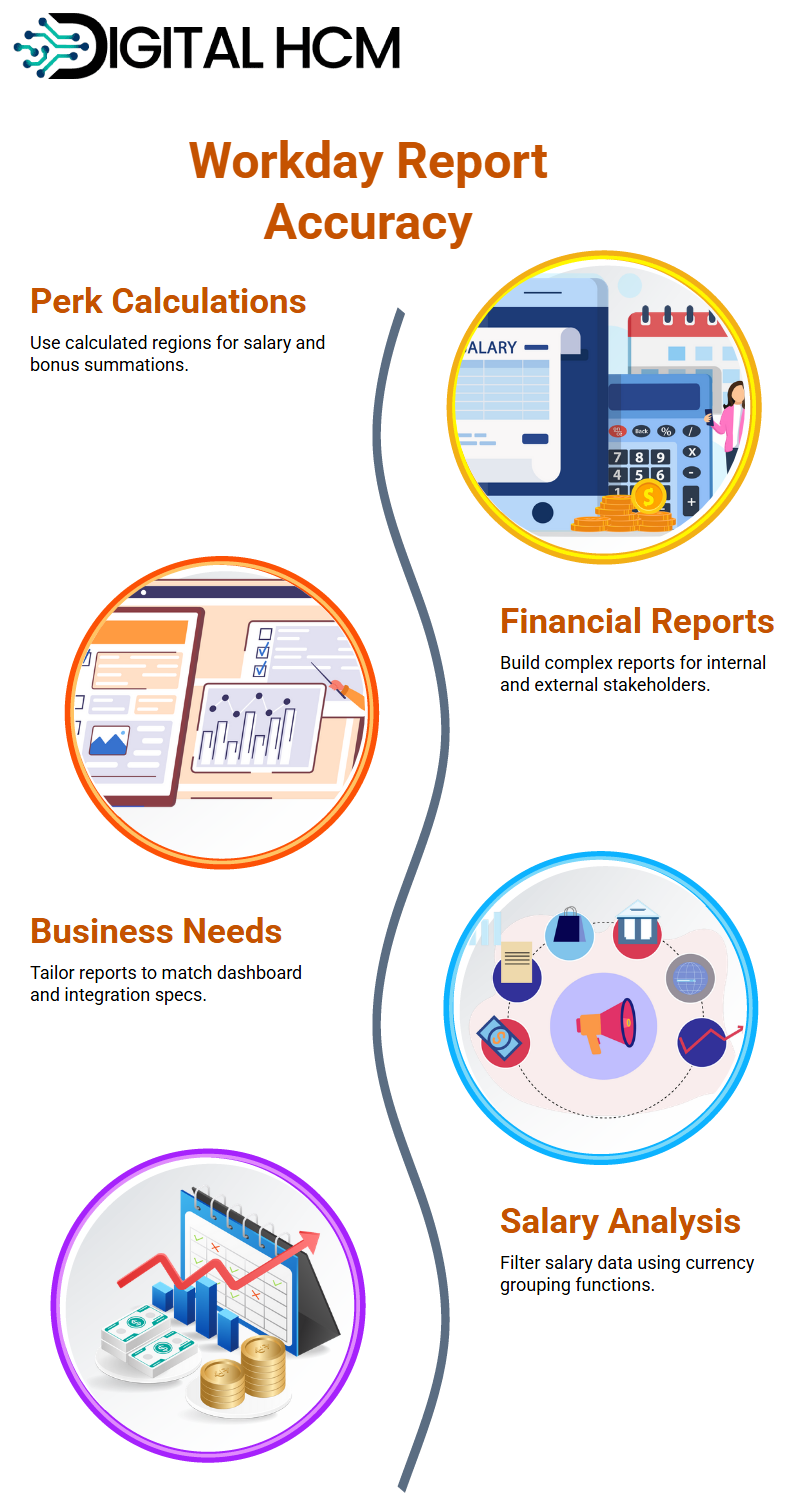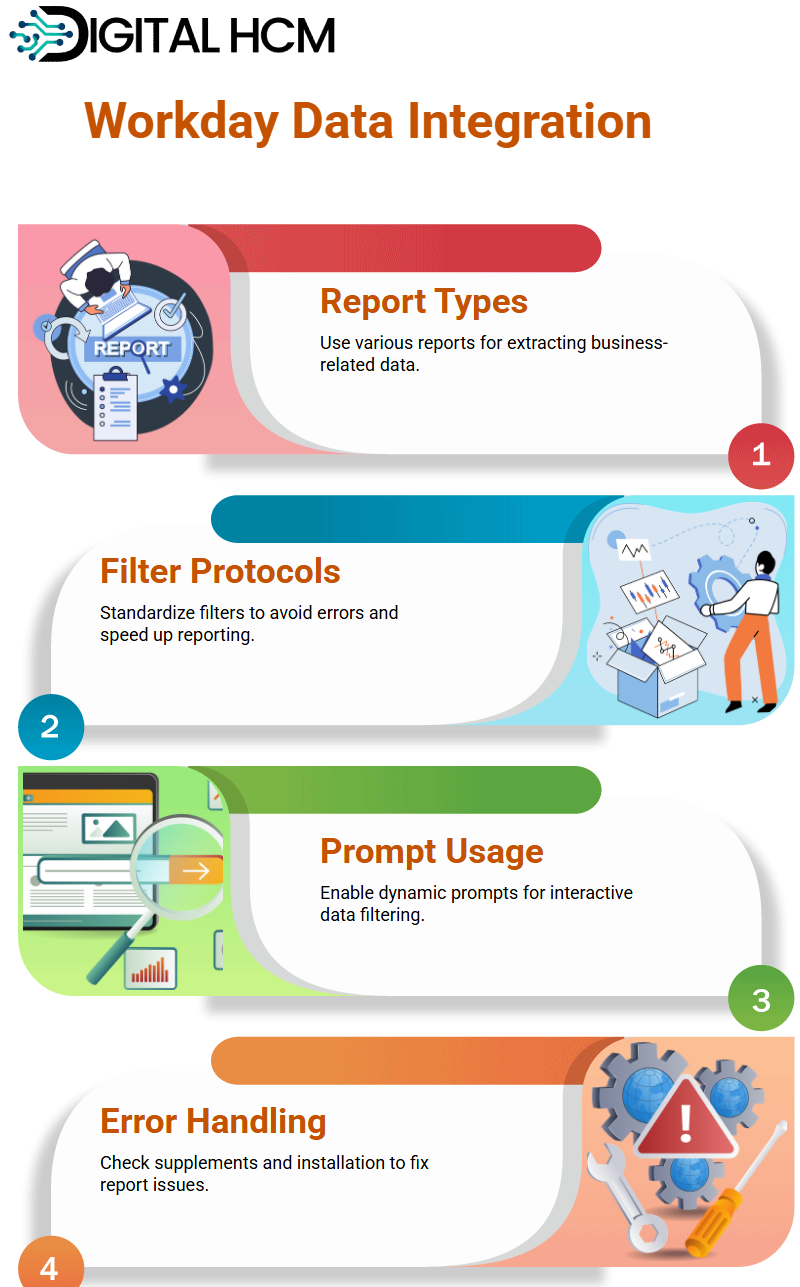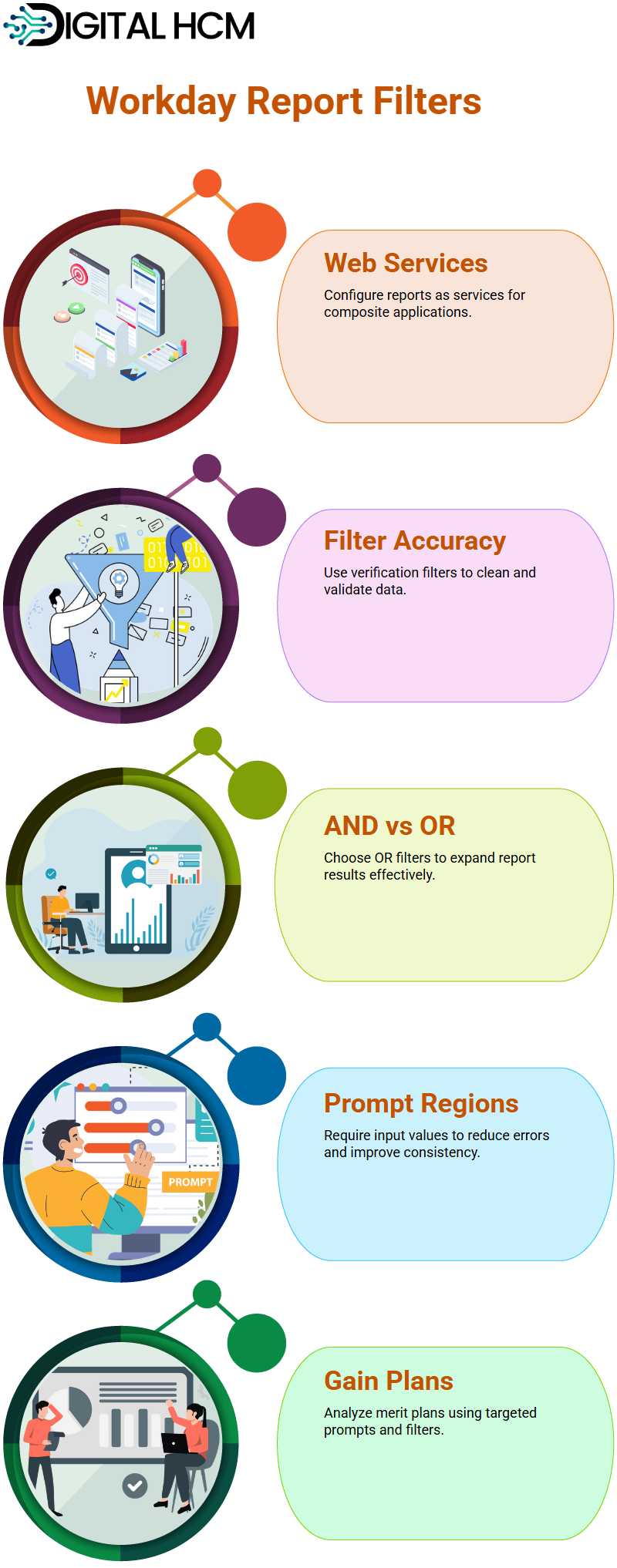Workday Training in New York City, New York, USA
Workday Reporting Tutorial
Workday Reporting
Workday Reporting provides users with an invaluable capability that enables them to generate tailor-made reports that meet all their reporting needs and become essential companions on any journey.
Today we will learn how to create ceremony reports using multiple categories for data visibility refinement.
Starting off by adding categories to your report. Consider including full names and school information to personalize it further. It is critical that no calculated zones remain for users to set up when creating simple reports using Workday Reporting: Choosing the Appropriate Zones.
For a deeper understanding of these steps, attending a Workday Reporting tutorial in USA can be very beneficial.
Workday Reporting makes managing data much simpler by setting aside specific zones to protect against false or inaccurate reporting. To keep information as trustworthy as possible, be sure to implement proper zones.
When marking as “worker”, full name details are immediately retrieved; for more precise categorization purposes it can help if employee is also used in this capacity.
You will encounter options like deleting actions within the interface; additionally, selecting suitable source fields will make report creation simpler and faster.
By understanding them better than before, report creation will go more smoothly than ever.
Filtering and Sorting Data in Workday Reporting
Workday Reporting offers powerful filtering and sorting functions, which enable it to quickly generate reports by narrowing results quickly and accurately.
Without setting conditions in your report, Workday searches all employee information; by changing filters you can narrow results directly related to what is needed in an instantaneous report.
Clarity in Workday Reporting for Employee Benefits
Workday Reporting serves as the system’s language when it comes to employee benefits. From this source we pull employee data about those beneficiaries of healthcare and medical plans; workday provides filters based on specific employee criteria so your list stays clean–no need for concern here!
Workday provides data for active staff while simultaneously filtering out those that have terminated employments or inactive staff statuses from being included on it.
Yesterday we created a report using Workday Reporting; today we’ll use it again while adding one extra step of focussing on its structure as an aid for more effectively deploying our merit plan.
Utilizing Workday Reporting, the benefits team can easily leverage employees’ data and deliver it directly to vendors for processing – providing employees with all their benefits uninterrupted without interruption or error.
Workday Reporting makes our data filtering efforts more effective, helping vendors obtain timely and accurate reports.
If you are new to this process or seeking to enhance your abilities, you may want to enroll in a Workday Reporting tutorial in New York.
It is an exceptional method for acquiring practical experience and implementing best practices in your own reporting requirements.

Workday Reporting through Active Employees
Workday Reporting often requires the establishment of controls over employees whose statuses may shift—from active to inactive and sometimes back again.
Managing these transitions is essential for ensuring clean and accurate data. That’s where employee active filters become especially valuable—they allow HR teams to precisely identify and focus on the active workforce within Workday itself.
Workday Reporting provides a fast and efficient solution for human resource departments to ensure that reports exclude individuals who are no longer functioning employees—such as those who are terminated, inactive, or otherwise not currently employed.
Instead, the system is designed to recognize and include only active participants in benefits programs—those who maintain a special status within your organization’s HR framework.
This streamlined data control brings substantial benefits to HR teams, enhancing both reporting accuracy and operational efficiency.
By leveraging Workday Reporting, businesses can reduce unnecessary data filtering and concentrate on the employee details that matter most.
This results in reports that are not only cleaner but also meet both internal HR requirements and external vendor standards.
Working together through Workday Reporting allows your organization to operate more smoothly, reduce manual oversight, and eliminate costly errors in employee data management.
For those looking to deepen their understanding or optimize their use of this powerful tool, enrolling in a Workday Reporting tutorial in New York can be an excellent next step.
These tutorials offer hands-on guidance and practical insights that can elevate your reporting capabilities to the next level.

Workday Reporting's Upside Plan Filters
With Workday Reporting, organizations can efficiently align employees with upside or merit-based plans by using targeted filters such as the ‘currently enrolled in benefits’ field.
This ensures that only eligible employees gain access to specific perks, while also maintaining accurate headcounts and preventing enrollment errors.
A common challenge in Workday Reporting involves managing employee leaves, especially short-term leaves like vacation or sick leave versus long-term leaves such as medical or parental leave.
While employees on short-term leave may remain active in the system, long-term leave requires more nuanced handling.
In these cases, Workday Reporting must be configured to reflect status changes accurately and ensure these employees remain informed and appropriately categorized.
One of the strengths of Workday Reporting is its flexibility each organization can customize the tool to reflect internal policy requirements, ensuring compliance and tailored reporting logic.
Whether tracking eligibility for medical plans, insurance coverage, or pension contributions, Workday plays an instrumental role in benefit administration by increasing visibility and minimizing manual effort.
By refining filters and data logic, HR teams can enhance transparency, reduce errors, and streamline benefits administration.
Consider going to a Workday Reporting tutorial in New York if your team wants to improve these skills.
HR professionals and system administrators can benefit greatly from Workday’s robust reporting features, particularly in intricate areas like leave management and benefits monitoring, by attending these workshops, which provide hands-on, practical learning.
Enhancing Workday Reporting to Report Vendor Data
Workday Reporting makes transmitting reports to vendors much simpler by automatically sending their appropriate gain appreciation reports, while easily formatting employee’s data with additional benefits providers.
Workday Reporting’s users can use advantage plans available through Workday Reporting to direct vendors towards collecting employee details they require for processing, such as medical coverage or pension plans. It facilitates file filtering so only relevant records will be selected.
Firms utilizing Workday Reporting typically benefit from having benefits data organized neatly so as to reduce errors when communicating to vendors.
With its carefully chosen employee perk plans and reporting capabilities, Workday Reporting ensures HR departments generate reports which meet supplier specifications with ease.
HR workers can further benefit from these features by taking advantage of a Workday Reporting lesson in New York.
Workday Reporting: A great feature of Workday Reporting is how well it makes use of our data, with benefits reports typically offering clear data that meets our exact requirements.
By eliminating irrelevant benefits such as those not related to health insurance entries, reports become transparent while your return assumption becomes accurate.
Workday Reporting’s most advantageous feature is its flexibility in dealing with business objects that relate to employees directly, like election outcomes and employee attendance numbers.
By applying lower rank filters, we are allowing relevant results only into positions we require; meaning reports can be customized according to organisation-wide needs and specific requests for each report.

Fine Tuning Workday Reporting for Perk Calculations
Calculations in Workday Reporting are critical components to providing accurate data, making a major contribution to its output.
We use Workday Reporting software to calculate salaries, bonuses or any other compensation components and then set calculated regions to complete that process efficiently and quickly.
When trying to come up with total salary-related terrain summations quickly and effortlessly using Workday Reporting is our go-to choice.
Attending a Workday Reporting Tutorial in New York can help you gain a deeper grasp of these tools and increase report-building accuracy.
To achieve accurate calculations, we select and organize solutions necessary to totalling financial data across many domains.
With Workday Reporting’s capabilities we will easily be able to build complex financial reports which help deliver what our internal and external customers require and easily understand them.
Enhancing Workday Reporting to Meet Business Needs
Workday Reporting offers businesses an efficient method for creating reports tailored to meet specific business requirements; its flexible reporting structure has evolved accordingly.
When creating reports pertaining to benefits, its key focus should be matching them up with integration specifications and dashboard integration specifications – thus Workday Reporting becomes the go-to platform for analysts.
To better understand these features and apply them effectively, many teams benefit from attending a Workday Reporting tutorial in NY, where practical skills are gained for navigating complex reporting tasks.
Some reporting deadlines can be stringently adhered to – which can be particularly daunting when handling them externally, such as consultants and contractors.
When this is being managed internally however, Workday Reporting becomes the ideal platform to create highly in-depth reports tailored precisely to the organization in which users reside.
Working With Workday Reporting for Salary Analysis
Not only can Workday Reporting assist our everyday operations, it is also an ideal platform for salary distribution analysis by filtering out unnecessary elements and providing filters with specific parameters that allow accurate filtering of relevant information.
Accuracy in data compilation and use are more essential than finding evidence; one feature of its sorting module in Workday Reporting that makes this possible is how its currency value grouping function allows integral addition of values together.
Developing these skills through a Workday Reporting tutorial in NY ensures teams can handle data confidently and use complex filters more effectively.
An issue encountered when working with large volumes of data is that not enough population counts are accurately represented by filters specific to one country or another; using such techniques ensure that only relevant Workday Reporting data surface for analysis; further supporting evidence through various selection factors can aid in providing further details of information.

Utilizing Workday Reporting for Simple Data Integration
Workday Reporting Tutorial in USA offers various report types to enable comprehensive data extraction.
Maintaining reports related to profit programs are paramount; thus, focusing on business objects and calculated domains must remain of top importance when creating reports that summarize business events ensure proper and smooth data management.
Integration of report data within Workday Reporting is critical to running an efficient business process.
From employee performance reporting to refining compensation terrains, Workday Reporting equips us with all of the essential tools for making our work smoother.
Workday Reporting as a Tool of Systematic Data Management
Organisations can leverage Workday Reporting as a powerful tool in data analysis quickly. Unexpected report appearance could be due to either forgotten continuations or improper filters.
By standardising protocols of filtering and prompting data for optimal reporting management speeds up reporting results significantly and faster management results are obtained.
Participating in a Workday Reporting tutorial in the USA may assist users understand how to avoid these issues by properly configuring and using filters.
Workday Reporting’s main error message focuses on an absence of supplements; once connected with your tenant for the first time, Workday Reporting will prompt you to fill in these essential supplements.
If the results were disappointing or you still do not wish to enlist help from IT, perhaps your installation process has been neglected; please recheck it for errors.
Customizing Prompts in Workday Reporting
Workday Reporting prompts enable users to filter data interactively. In contrast to fixed filters, customers are now able to select specific parameters dynamically during runtime if required.
With over 10,000 employees at most companies worldwide in your organization it would be nearly impractical for one reporter to compile all these reports individually; Workday Reporting steps up as the perfect solution that allows specific questions be answered through prompts.
Workday Reporting’s Prompt User for Value function requires users to enter all required values before accessing a report.
Similarly, this element achieves this same function and therefore the user can still activate this element if that option is unavailable; increasing usability while only showing relevant data for display purposes.

Workday Reporting and Web Service-Enabled Reports
One powerful feature of Workday Reporting Tutorial in USA is its capability of being configured as web services; this enables us to facilitate creation of composite applications or provide prompt values correctly or else Workday Reporting will refuse the request and say it cannot be done.
Workday Reporting offers two categories of reports; standard and web service-enabled reports. Automated customer-defined service points allow this second type to function like applications.
Enhancing Report Correctness with Workday Reporting Filters
Workday Reporting Filters are one of the most thorough data cleaning strategies, where data are verified and validated through verification filters.
In order for this process to succeed successfully, its filter operator should meet specific expectations to be successful in conducting it successfully.
Filtering processes within Workday Reporting that use “AND” instead of ‘OR” as one option are likely to produce limited results while increasing selection via OR increases this number significantly.
Workday Reporting allows the user to simultaneously customize multiple reports. Filters used for extracting employee or financial records or data should be understood with regards to how they interact with prompts; this method is especially efficient at getting to the heart of an intricate topic without resorting to traditional data science approaches while remaining on top of results analysis.
Utilizing Workday Reporting in Gain Plan Analysis
Workday Reporting can be an indispensable asset when examining merit plans.
Through prompts, business owners can select unambiguous reports they desire and eventually narrow them down until finding only those relevant ones that provide value to the organization.
Previously impossible in time constraints can now be accomplished with just a few clicks thanks to Workday Reporting resulting in exactly why someone may need this data in question!
Workday Reporting features another important element, prompt regions mandatory.
This ensures users provide necessary input values before running reports thereby decreasing mistakes and increasing data uniformity.


James

Success in your career comes from curiosity, courage, and consistency. Stay committed, stay curious and never stop learning.
